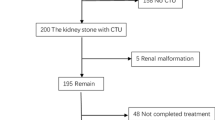Abstract
Purpose
To externally validate Resorlu–Unsal stone score (RUSS) and to evaluate its predictive accuracy.
Methods
Data of patients who underwent retrograde intrarenal surgery (RIRS) between October 2013 and June 2015 were collected. RUSS was applied to all patients, and the nomogram was externally validated. Area under the curve (AUC) was used for clinical validity assessment.
Results
A total of 85 patients were included in the study. Mean patient age was 54.3 ± 16.5, and mean stone size was 12.0 ± 6.21 mm. After applying RUSS, 56.5, 28.2, 9.41, and 5.88 % had score 0, 1, 2, and 3, respectively. RUSS was significantly associated with stone location and size. Postoperative stone-free rate was 74.1 %. Postoperative outcomes were significantly associated with RUSS and stone size. RUSS was found to be the only significant independent predictor in multivariate analysis, while it provided high predictive accuracy with an estimated AUC of 0.707.
Conclusions
RUSS is a simple scoring system that may predict postoperative stone-free rate after RIRS with great efficacy and accuracy.

Similar content being viewed by others
References
De S, Autorino R, Kim FJ et al (2015) Percutaneous nephrolithotomy versus retrograde intrarenal surgery: a systematic review and meta-analysis. Eur Urol 67:125–137
Srisubat A, Potisat S, Lojanapiwat B, Setthawong V, Laopaiboon M (2014) Extracorporeal shock wave lithotripsy (ESWL) versus percutaneous nephrolithotomy (PCNL) or retrograde intrarenal surgery (RIRS) for kidney stones. Cochrane Database Syst Rev 11:CD007044
Wendt-Nordahl G, Mut T, Krombach P, Michel MS, Knoll T (2011) Do new generation flexible ureterorenoscopes offer a higher treatment success than their predecessors? Urol Res 39:185–188
Hussain M, Acher P, Penev B (2011) Cynk M (2011) Redefining the limits of flexible ureterorenoscopy. J Endourol 25:45–49
Aboumarzouk OM, Monga M, Kata SG, Traxer O, Somani BK (2012) Flexible ureteroscopy and laser lithotripsy for stones >2 cm: a systematic review and meta-analysis. J Endourol 26:1257–1263
Breda A, Ogunyemi O, Leppert JT, Lam JS, Schulam PG (2008) Flexible ureteroscopy and laser lithotripsy for single intrarenal stones 2 cm or greater–is this the new frontier? J Urol 179:981–984
Thomas K, Smith NC, Hegarty N, Glass JM (2011) The Guy’s stone score–grading the complexity of percutaneous nephrolithotomy procedures. Urology 78:277–281
Okhunov Z, Friedlander JI, George AK et al (2013) S.T.O.N.E. nephrolithometry: novel surgical classification system for kidney calculi. Urology 81:1154–1159
Smith A, Averch TD, Shahrour K et al (2013) A nephrolithometric nomogram to predict treatment success of percutaneous nephrolithotomy. J Urol 190:149–156
Kanao K, Nakashima J, Nakagawa K et al (2006) Preoperative nomograms for predicting stone-free rate after extracorporeal shock wave lithotripsy. J Urol 176:1453–1456
Abdel-Khalek M, Sheir KZ, Mokhtar AA, Eraky I, Kenawy M, Bazeed M (2004) Prediction of success rate after extracorporeal shock-wave lithotripsy of renal stones–a multivariate analysis model. Scand J Urol Nephrol 38:161–167
Resorlu B, Unsal A, Gulec H, Oztuna D (2012) A new scoring system for predicting stone-free rate after retrograde intrarenal surgery: the “resorlu–unsal stone score”. Urology 80(3):512–518
Dindo D, Demartines N, Clavien PA (2004) Classification of surgical complications: a new proposal with evaluation in a cohort of 6336 patients and results of a survey. Ann Surg 240:205–213
Zhang W, Zhou T, Wu T et al (2015) Retrograde intrarenal surgery versus percutaneous nephrolithotomy versus extracorporeal shockwave lithotripsy for treatment of lower pole renal stones: a meta-analysis and systematic review. J Endourol 29:745–759
Elbahnasy AM, Shalhav AL, Hoenig DM et al (1998) Lower caliceal stone clearance after shock wave lithotripsy or ureteroscopy: the impact of lower pole radiographic anatomy. J Urol 159:676–682
Author information
Authors and Affiliations
Corresponding author
Ethics declarations
Conflict of interest
Stavros Sfoungaristos declares that he has no conflict of interest, Ofer N. Gofrit declares that he has no conflict of interest, Ioannis Mykoniatis declares that he has no conflict of interest, Ezekiel H. Landau declares that he has no conflict of interest, Ioannis Katafigiotis declares that he has no conflict of interest, Dov Pode declares that he has no conflict of interest, Constantinos A. Constantinides declares that he has no conflict of interest, and Mordechai Duvdevani declares that he has no conflict of interest.
Ethical approval
This article does not contain any studies with animals performed by any of the authors. All procedures performed in studies involving human participants were in accordance with the ethical standards of the institutional and national research committee and with the 1964 Helsinki declaration and its later amendments or comparable ethical standards.
Informed consent
The present study is retrospective and no informed consent was obtained.
Rights and permissions
About this article
Cite this article
Sfoungaristos, S., Gofrit, O.N., Mykoniatis, I. et al. External validation of Resorlu–Unsal stone score as predictor of outcomes after retrograde intrarenal surgery. Int Urol Nephrol 48, 1247–1252 (2016). https://doi.org/10.1007/s11255-016-1311-2
Received:
Accepted:
Published:
Issue Date:
DOI: https://doi.org/10.1007/s11255-016-1311-2




